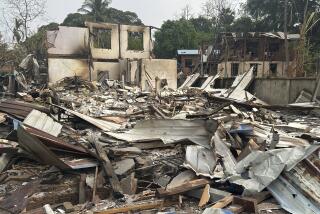Buffer Against Vietnamese Now Gone : Future of Cambodian Rebel Struggle in Doubt
- Share via
BANGKOK, Thailand — Four months ago, the border camps of the Cambodian resistance provided a base of military operations, some legitimacy for what the guerrillas called “Free Cambodia,” and a buffer between Thailand and the Vietnamese occupation army in Cambodia.
With the fall Monday of Prince Norodom Sihanouk’s guerrilla headquarters at Tatum, the buffer is gone and the strength of the three-party resistance coalition and its ability to carry on the war is in question.
On Tuesday, Vietnamese troops were deployed along a long stretch of the Thai-Cambodian border formerly controlled by elements of the resistance--from the former Khmer Rouge base at Phnom Malai in the south, through the overrun headquarters of the non-Communist Khmer People’s National Liberation Front in the central sector opposite the Thai border town of Aranyaprathet, to Tatum, northeast of Aranyaprathet.
At Tatum, the Vietnamese also occupied parts of two hills on Thai territory used in the assault on the Sihanouk base, according to reports confirmed by a Western diplomat.
During Chinese Visit
The fall of Tatum had an added sting because it came during the visit to Thailand of Chinese President Li Xiannian, whose government has been the main supporter and supplier of the resistance forcers in their fight against the Vietnamese.
Hanoi’s troops invaded Cambodia in December, 1978, drove the brutal Khmer Rouge regime from power, and installed a government under Heng Samrin in Phnom Penh, the Cambodian capital. In every dry season since, the Vietnamese have attacked the border camps of the rebels--a coalition of the Communist Khmer Rouge and the non-Communist guerrillas of Sihanouk and of former Cambodian Premier Son Sann’s Khmer Front.
This years’ offensive has been by far the strongest. All the major resistance bases on the border have been overrun. The Vietnamese are now expected to turn their attention to smaller guerrilla concentrations in the frontier area, according to military and diplomatic analysts, and to maintain their deployments on the border.
Difficulties for Thailand
The Vietnamese victories present Thailand and the resistance forces with serious problems. The Thais must deal immediately with the presence of Vietnamese troops on their own territory. The most serious incursion--others have been reported in the last week--is the one near Tatum.
Deputy Defense Minister Taniang Karntarat reported in Bangkok on Tuesday that more Thai troops have been sent to the area, and that Thai jets and artillery are trying to drive the Vietnamese off Thai soil.
Thai authorities must also deal with a flood of about 250,000 Cambodian refugees who have sought sanctuary in Thailand. The refugees and the guerrillas made up the now-evaporated buffer area between Thai forces and the Vietnamese.
The Cambodian guerrillas face the hardest task. Deprived of their border camps, their supply and communications lines disrupted if not destroyed by the Vietnamese cordon along the frontier, the guerrillas must somehow carry the battle to the Vietnamese to maintain their struggle.
Guerrillas Turn Refugees
Before the dry-season offensive began, the guerrillas’ combined strength was estimated at more than 50,000 men deployed against a Vietnamese army of 160,000 to 180,000, plus an estimated 30,000 trooPs of the Heng Samrin government.
Where are the 50,000 guerrillas now? The Western diplomat estimated that nearly half of them are in refugee camps in Thailand. Thai spokesmen say the guerrillas were disarmed as they crossed the frontier to deprive the Vietnamese of an excuse for making the camps a target.
The rest of the guerrillas have reported infiltrated into the Cambodian interior, leaving the border bases before the final onslaught in order to carry on operations behind Vietnamese lines. “The Vietnamese found nothing but an empty camp while some of our commandos were immediately sent to operate behind the enemy,” said Troug Mealy, a Sihanouk spokesman discussing the fall of Tatum.
Mealy said Sihanouk’s soldiers suffered more than 20 killed and 100 wounded in the Vietnamese assault on Tatum, which began March 5. He estimated the Vietnamese dead at 1,000, but Thai military spokesmen and Western envoys have used lower figures.
The question at Tatum was how many of the estimated 3,000 defenders were able to escape the final assault by a Vietnamese force estimated at twice that number. “So far it looks like they got out in good shape,” the Western diplomat said.
More to Read
Sign up for Essential California
The most important California stories and recommendations in your inbox every morning.
You may occasionally receive promotional content from the Los Angeles Times.













